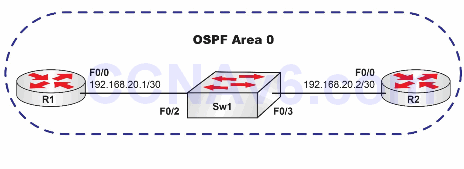Lab Objective:
The objective of this lab exercise is for you to learn and understand how to enable OSPF on broadcast network types. These include Ethernet and Token Ring (although you are not likely to encounter Token Ring).
Lab Purpose:
Enabling OSPF on broadcast network types is a fundamental skill. OSPF is the most popular Interior Gateway Protocol (IGP) and it is imperative to understand how OSPF adjacencies are established on broadcast network types. OSPF uses the concept of Areas. In order for two OSPF-enabled routers to establish an adjacency, they must reside in the same OSPF Area. Unlike EIGRP, which uses ASNs, OSPF is enabled using a locally significant process ID. As a Cisco engineer, as well as in the Cisco CCNA exam, you will be expected to know how to enable OSPF on point-to-point network types.
Certification Level:
This lab is suitable for ICND2 and CCNA certification exam preparation.
Lab Difficulty:
This lab has a difficulty rating of 5/10.
Readiness Assessment:
When you are ready for your certification exam, you should complete this lab in no more than 10 minutes.
Lab Topology:
Please use the following topology to complete this lab exercise:

Task 1:
Configure hostnames on R1, R2, and Sw1 as illustrated in the topology.
Task 2:
Configure VLAN4010 on Sw1 and name it OSPF_VLAN. Assign ports FastEthernet0/2 and FastEthernet0/3 to this VLAN as access ports. Configure IP addresses on R1 and R2 FastEthernet0/0 interfaces and enable them.
Task 3:
Enable OSPF in area 0 between R1 and R2. For R1, use OSPF process ID 1, and for R2, use OSPF process ID 2. Verify that your OSPF adjacency has formed between R1 and R3. Also verify that the default network type for the Ethernet link between R1 and R2 is broadcast.
Configuration and Verification
Task 1:
For reference information on configuring hostnames, please refer to earlier labs.
Task 2:
For reference information on configuring IP addressing, transparent switching, and extended VLANs, please refer to earlier labs.
Task 3:
R2#conf t Enter configuration commands, one per line. End with CTRL/Z. R2(config)#router ospf 2 R2(config-router)#network 192.168.20.0 0.0.0.3 area 0 R2(config-router)#^Z R2# R1#conf t Enter configuration commands, one per line. End with CTRL/Z. R1(config)#router ospf 1 R1(config-router)#network 192.168.20.0 0.0.0.3 area 0 R1(config-router)#end R1# Mar 1 01:53:20.828: %OSPF-5-ADJCHG: Process 1, Nbr 192.168.20.2 on FastEthernet0/0 from LOADING to FULL, Loading Done R1#show ip ospf neighbor Neighbor ID Pri State Dead Time Address Interface 192.168.20.2 1 FULL/DR 00:00:37 192.168.20.2 Fast 0/0 R1#show ip ospf interface fastethernet 0/0 FastEthernet0/0 is up, line protocol is up Internet Address 192.168.20.1/30, Area 0 Process ID 1, Router ID 192.168.20.1, Network Type BROADCAST, Cost: 1 Transmit Delay is 1 sec, State BDR, Priority 1 Designated Router (ID) 192.168.20.2, Interface address 192.168.20.2 Backup Designated router (ID) 192.168.20.1, Interface address 192.168.20.1 Timer intervals configured, Hello 10, Dead 40, Wait 40, Retransmit 5 oob-resync timeout 40 Hello due in 00:00:04 Index 1/1, flood queue length 0 Next 0x0(0)/0x0(0) Last flood scan length is 1, maximum is 1 Last flood scan time is 0 msec, maximum is 0 msec Neighbor Count is 1, Adjacent neighbor count is 1 Adjacent with neighbor 192.168.20.2 (Designated Router) Suppress hello for 0 neighbor(s)
NOTE: On broadcast and non-broadcast multi-access networks, OSPF elects a designated router and a backup designated router for the subnet. When you are verifying OSPF adjacencies on these network types, make sure that the state is either FULL/DR, FULL/BDR, or FULL/DROTHER. The output of the show ip ospf interface command shows that the elected DR is R2, Designated Router (ID) 192.168.20.2, and that R1 is the BDR, Backup Designated router (ID) 192.168.20.1.
